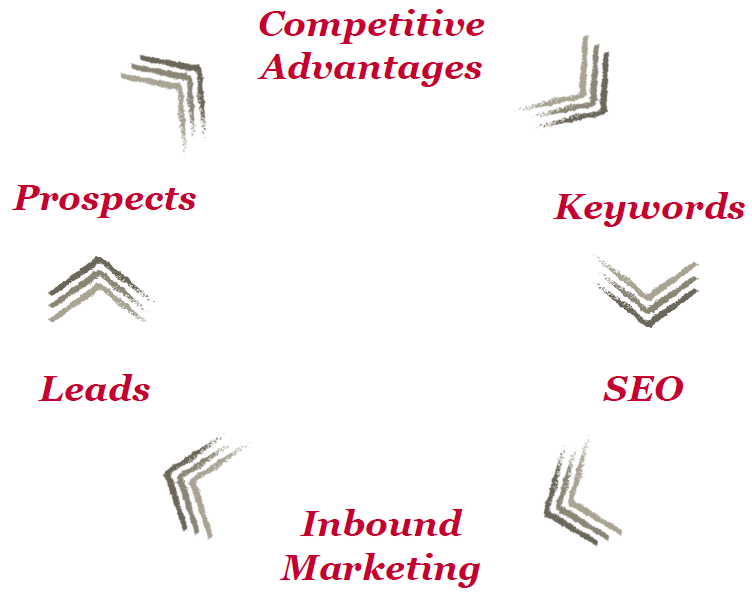I’m a new Hubspot enthusiast – to me, they are the gurus of inbound marketing. A noteworthy benefit of inbound marketing is its ability to reach a highly targeted audience. Brian Halligan, CEO & Co-Founder of HubSpot, and the pioneer of the inbound marketing concept, offers this advice: “rather than doing outbound marketing to the masses of people who are trying to block you out, I advocate doing inbound marketing where you help yourself ‘get found’ by people already learning about and shopping in your industry.” Today, inbound marketing is an essential link to a successful online presence – however it is not an effort that is easily undertaken, and it requires time and dedication to master.
 Part of my advocacy for Hubspot stems from the value I get from their blog; it truly helps educate users on how to maximize inbound marketing efforts. A recent blog, Top SEO Tips from the Industry Experts by Hubspots’ Anum Hussain, called my attention to a very keen connection between keywords, competitive advantages, and inbound marketing. Hussain quotes SEO.com’s Greg Shuey by urging inbound marketers to “think about the value you want to provide and which keywords match that value.”
Part of my advocacy for Hubspot stems from the value I get from their blog; it truly helps educate users on how to maximize inbound marketing efforts. A recent blog, Top SEO Tips from the Industry Experts by Hubspots’ Anum Hussain, called my attention to a very keen connection between keywords, competitive advantages, and inbound marketing. Hussain quotes SEO.com’s Greg Shuey by urging inbound marketers to “think about the value you want to provide and which keywords match that value.”
My argument:
I want to provide the value that my customers consider valuable!
The disconnect lies in the fact that so many companies fail to articulate and communicate what their customer’s truly consider valuable; therefore their marketing, sales messaging, SEO keyword focus and inbound marketing efforts are all thrown off.
Do you know what the return on investment is for finding out what your customers really value? Countless companies consider themselves ‘customer focused’ or ‘customer centric’ (have you ever google’d the phrase(s)? try it and see how many results come up)… yet only 10% invest in customer research to find out what their customers want; of that 10%, how many do you think actually use that research to tailor their business efforts to their market?
Identifying what your customers and prospects consider valuable, focusing on providing and matching that value, and then communicating that with specific, relevant competitive advantages will give your sales force and marketing team the answer to:why should I buy from you instead of your competition?
How to Use Your Competitive Advantage to Strengthen Your Inbound Marketing
Using your competitive advantages to strengthen your inbound marketing efforts doesn’t require a considerable budget or highly technical expertise; neglecting to do so leaves tons of profit on the table.
You can and should do this…here’s how:
- Research. Do some research to find out what your customers and prospects consider most valuable. Discover how your company identifies with those desires and convert them into relevant competitive advantages that you can prove and tout proudly.
- Spot. Spot out keywords and terms that will relate to your customer. Break each competitive advantage statement down into single and/or long tailed keywords. Consider what words and terms your customer might use to find the product or service you offer. Be detailed and creative! Ask those outside your industry for their input, brainstorm with co-workers over a working lunch, contact clients and ask how they searched for you in the past, etc.
- Tip: Keyword Analysis Tools. Like those offered by Hubspot can help you discover (and track) your most effective keywords. You need to know (not guess) what keywords and terms people are using to search for the services or products you sell.
- Incorporate. Incorporate the targeted and long-tailed keywords you have identified into your inbound marketing campaign.
Focus your SEO keywords and inbound marketing topics on what your customers consider valuable – potential competitive advantages. Create web pages and blogs focused on these values and Google will logically connect your customers to your website! Greg Shuey maps this out very clearly – “pick the best keywords around which to base each of your pages making it clear to search engines that your page revolves around those keywords.”
How do consumers search for what they want these days? Search engines. Therefore we as companies need to communicate with the search engines! “Hey Google – I have what that consumer is looking for – send them my way!”
Incorporating your competitive advantage keywords into your inbound marketing effort is how you target qualified leads – prospects who already know what they are looking for, now just need to find the right provider; it’s up to your company to offer what they need, and let them know it.
- How do you currently determine your SEO keyword focus? Is it probably using the same keywords that your competition uses?
- Are you part of the 10% that has invested in research to find out what your customers value? If so, how do you use that information? If not, why haven’t you?
